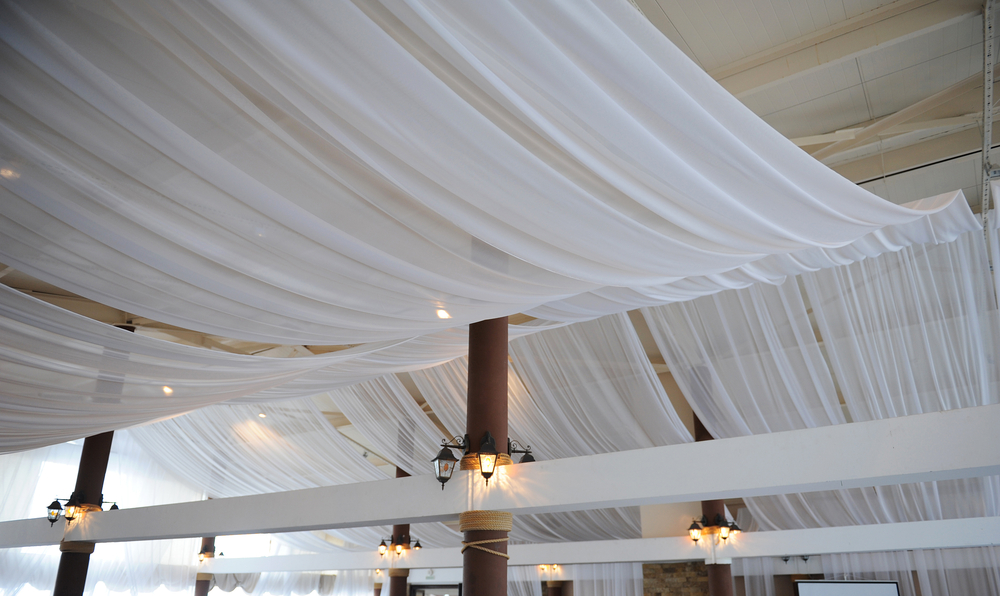When transforming your space into an elegant haven, drape hold an undeniable role. These fabric panels, draped gracefully from the ceiling to the floor, bring aesthetics, privacy, and functionality to any room. They’re not just window dressing but an integral element of home decor that can dramatically change a room’s mood and appearance.
Let’s picture a drape hanging from the ceiling, making your ceilings appear higher, adding a dash of grandeur, or creating a cozy, intimate space. Ceiling-hung drape introduce a different dynamic to room decor. They change our perception of space and can turn an ordinary room into a stylish, unique, inviting space.
This article is here to demystify the process of hanging drape from the ceiling. Worry no more if you’ve been considering this decorative step but feel daunted by how to do it. We’ll walk you through the entire process, from picking the suitable fabric to measuring your space, selecting the appropriate hardware, and finally, hanging your drape with finesse.
Jump Links
- Benefits Of Hanging Drape From The Ceiling
- Considerations Before Hanging Ceiling Drape
- Tools And Materials Needed For Installation
- A Step-By-Step Guide To Hanging Drape From The Ceiling
- Installing The Brackets Or Rod Holders
- Installing Tracks
- Attaching And Adjusting The Drape
- Caring For Your Ceiling Drape
- The Ultimate Guide To Hanging Drape From The Ceiling
Benefits Of Hanging Drape From The Ceiling
Drape can dramatically alter the ambiance of a room, but hanging them from the ceiling has benefits that extend beyond simple aesthetics. Let’s unpack the transformative power of ceiling-hung drape.
Creating An Illusion Of Height And Space
Ever walked into a room and felt awestruck by its spaciousness, only to realize it’s not that large? The room utilized design tricks to create this illusion, and one effective method is hanging drape from the ceiling. By placing your drape closer to the ceiling rather than the top of the window, you visually elongate the wall, making the room appear taller and more spacious. It’s a simple trick but incredibly effective for spaces of all sizes.
Adding A Dramatic And Luxurious Feel To A Room
Ceiling drape aren’t just about functionality; they bring a whole new level of aesthetics to your space. They imbue rooms with a sense of grandeur, drama, and luxury. Think of how a lush velvet curtain falling from a lofty ceiling can transform a mundane space into a glamorous setting reminiscent of opulent ballrooms or decadent theater stages. The theatrical aspect of drape can genuinely elevate your interior design.
Enhancing Lighting Control And Privacy
Functionality is a crucial aspect of any decor decision, and ceiling drape excel in this regard. Hanging drape from the ceiling provides an extra layer of light control, enabling you to manipulate the room’s brightness to your liking. Furthermore, they offer enhanced privacy, especially in rooms with tall, expansive windows.
Ability To Cover Unattractive Architectural Features
If you’re dealing with unappealing architectural elements such as uneven ceilings, visible pipes, or unsightly fixtures, ceiling-hung drape are a stylish solution. They act as a cover-up, directing attention away from the less appealing aspects of your room. Essentially, they provide an aesthetic camouflage, making it easy to create a polished look regardless of your room’s inherent challenges.
Considerations Before Hanging Ceiling Drape
While the prospect of hanging drape from the ceiling is exciting, careful planning is necessary to ensure a stunning outcome. Several aspects require thoughtful consideration, from choosing the suitable fabric and color to understanding drape fullness and length.
Choosing The Right Fabric And Color
The choice between light and heavy fabrics largely depends on the look you’re aiming for and the room’s functionality.
Light Versus Heavy Fabrics
Light fabrics, like linen or cotton, create a casual, breezy feel and softly filter sunlight. Heavy fabrics like velvet or brocade provide a formal, insulating, and light-blocking effect. Your choice should align with your room’s purpose and the ambiance you want to create.
Solid Colors Versus Patterns
Choosing between solid colors and patterns is another vital decision. Solid colors offer a timeless look and make a space feel larger. On the other hand, patterns can inject vibrancy and personality into a room. They also help in hiding minor stains or wear and tear. It’s essential to pick a color or pattern that complements your existing décor and reflects your style.
Understanding Drape Fullness And Length
The fullness and length of your drape significantly impact its aesthetic appeal. Fullness refers to the amount of fabric used in the drape, with a fuller drape appearing more luxurious. As for length, floor-length drape provide a classic, clean look, while drape that puddle on the floor give a romantic, opulent feel. You must decide on the fullness and length based on your room’s size and your taste.
Tools And Materials Needed For Installation
Here’s a list of the tools, materials, and safety considerations necessary to hang your drape from the ceiling successfully.
Required Tools
- Ladder
- Measuring tape
- Pencil for marking
- Drill with appropriate bits
- Screwdriver
- Level
- Scissors
Materials Needed
- Drape or curtains of your choice
- Curtain rod matching the width of your window
- Traditional brackets or rod holders
- Screws matching the type required for your ceiling
- Adhesive curtain hooks (suitable for renters)
- Tracks and brackets (if you don’t want rods)
- Anchors (if necessary for your ceiling type)
- Curtain rings or clips (matching the style of your drape)
- Optional: Tiebacks or holdbacks for added functionality and style
Safety Considerations
To ensure a safe installation process, here are a few key points to keep in mind:
- Use a sturdy and stable ladder that’s the right height for your task.
- Do not use power tools without the necessary knowledge and precautions.
- Use a level to ensure your brackets and rods are perfectly horizontal.
- Be cautious of drilling into any electrical wires or pipes. Always check the area behind the drilling spot.
- Be aware of the weight limitations of your mounting hardware to prevent falling objects.
- If the drape is heavy or the installation process complex, consider getting professional help.
- Ensure your work area is clear of pets and children during installation.
- Wear safety glasses when drilling to prevent dust or debris from getting into your eyes.
A Step-By-Step Guide To Hanging Drape From The Ceiling
In this step-by-step guide, we’ll walk you through hanging drape from the ceiling, ensuring a successful installation.
Measuring The Space Accurately
Before you start hanging drape from the ceiling, accurate measurements are crucial. Here are the key steps to follow. Using a tape measure:
- Measure the Height: Start with the distance from the ceiling to the floor to determine the drape length.
- Measure the Width: Measure the window’s width and add 6-8 inches. The total fabric width should be 1.5-2 times this value for fullness. Of course, you can make this as long as you need for your desired fullness.
- Consider the Length: To avoid bunching, if you want drape to hover just above the floor, subtract about 1 cm (or 0.5 inches) from the height measurement.
Mark the areas with the pencil so you can install the brackets and get a drape matching those measurements.
Installing The Brackets Or Rod Holders
Next, it’s time to install the brackets or rod holders supporting the curtain rod. The method you choose will depend on your specific situation. If you’re renting or have brick walls that are difficult to drill into, you can opt for adhesive curtain hooks instead.
For traditional installation with brackets or rod holders:
- Use a stud finder or a tapping method to locate the ceiling studs or joists along the marked lines. Studs provide the best support for the brackets.
- Once you’ve located the studs, hold the bracket against the ceiling and mark the position of the screw holes using a pencil.
- Pre-drill pilot holes at the marked positions to make it easier to insert the screws.
- Align the bracket with the pilot holes and attach it securely to the ceiling using the screws provided with the brackets. Repeat this step for all brackets needed.
For Adhesive Curtain Hooks (Renter-Friendly Option):
- Clean the ceiling surface thoroughly to ensure proper adhesion.
- Peel off the backing from the adhesive hooks and firmly press them onto the ceiling, following the marked lines.
- Allow the adhesive hooks to set for the recommended time before proceeding to the next steps.
Attaching The Rod And Drape
Once the brackets or adhesive hooks are securely in place, it’s time to attach the curtain rod and hang the drape. Follow these steps:
- Slide the curtain rod through the rod pocket or rings of the drape.
- Lift the curtain rod and carefully position it onto the installed brackets or adhesive hooks. Ensure that the rod rests securely in place.
- If using rings, attach the drape to the rings by sliding the rings onto the rod.
Safety Checks And Adjustments
Lastly, perform safety checks to ensure the installation is secure and safe:
- Ensure the curtain rod is securely attached to the brackets or adhesive hooks.
- Confirm that the brackets or adhesive hooks are firmly fixed to the ceiling.
Installing Tracks
If you’re choosing tracks over rods, here are the steps you should follow:
- Measure the width of your window to determine the track length.
- Mark where you’ll place the brackets, ensuring they’re level.
- Drill holes where you marked for the brackets.
- Attach the brackets using screws.
- Click the track into the brackets.
- Slide the drapery hooks or clips onto the track.
Attaching And Adjusting The Drape
The final yet crucial steps in drapery: attachment and adjustment post-installation.
Hanging the drape from rods or tracks:
- Slide your drape onto the rod or track. Ensure they’re evenly spaced.
- If your drape has rings or hooks, thread these onto the rod or the track sliders.
- Make sure the drape opens and closes smoothly.
- Double-check that the drape is hung correctly and does not pose a tripping hazard or risk of entanglement.
Adjusting The Drape Length And Fold
- Let the drape hang for a day to settle into its natural length.
- Adjust the folds by hand so they drape elegantly.
- To shorten, use hemming tape for a no-sew fix, or stitch a new hem.
Styling And Accessorizing The Drape
- Use tiebacks for a traditional look. These gather your drape neatly to the side when open.
- For a modern style, try magnetic curtain holdbacks.
- Consider finials – decorative ends for your curtain rods that add a stylish touch.
Caring For Your Ceiling Drape
Ensuring your ceiling drape’s longevity and aesthetic appeal requires some basic yet essential care. Simple practices and quick fixes can help maintain your drape in top condition.
Regular Cleaning And Maintenance
To keep your ceiling drape in good shape, clean them gently and regularly. Use a feather duster or vacuum with a soft brush attachment to remove dust and cobwebs. Make sure to clean both sides of the drape to avoid dust buildup. If your drape is machine washable, follow the manufacturer’s instructions carefully. When washing, use a gentle cycle and cold water to prevent damage. Never wring out your drape; let them air dry to maintain their shape and texture.
Problem-Solving And Troubleshooting
If you notice your drape are losing their vibrancy or have persistent stains, it might be time for some problem-solving. First, try spot cleaning with a mild detergent and warm water. If the stain remains, you may need professional cleaning.
Is the drape sagging or not hanging correctly? Check the attachment points and hardware. They might need tightening or replacing. Always handle your drape with care to avoid tearing the fabric. Remember, keeping your drape in top shape requires regular attention and prompt action when issues arise.
The Ultimate Guide To Hanging Drape From The Ceiling
Hanging drape from the ceiling can transform any room into a more inviting, stylish, and spacious space. Remember, this process is not just about aesthetics; it’s a practical approach to enhancing privacy, controlling light, and covering up less appealing elements in your room. Whether you opt for light, breezy fabrics or heavy, luxurious ones, remember to make your choice align with your room’s purpose and desired ambiance.
Remember to care for your drape regularly to keep them looking their best. With the proper care, your ceiling drape can be a lasting statement piece in your home. Embrace this beautiful design trick to uplift your interiors to a whole new level.


